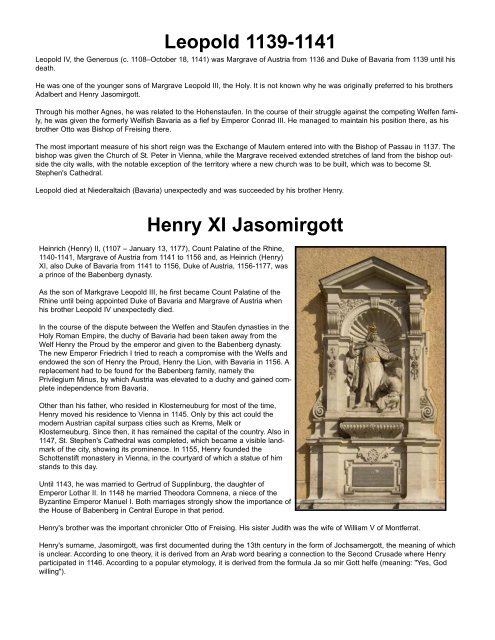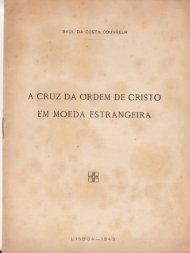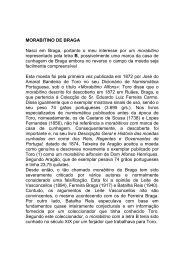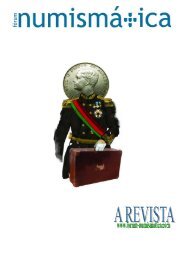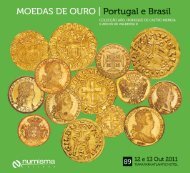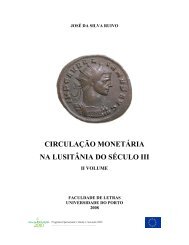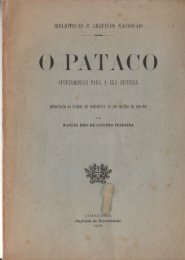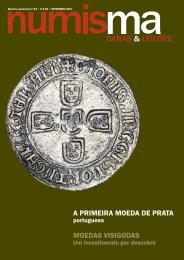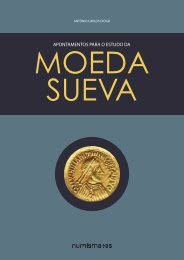You also want an ePaper? Increase the reach of your titles
YUMPU automatically turns print PDFs into web optimized ePapers that Google loves.
Leopold 1139-1141<br />
Leopold IV, the Generous (c. 1108–October 18, 1141) was Margrave <strong>of</strong> Austria from 1136 and Duke <strong>of</strong> <strong>Bavaria</strong> from 1139 until his<br />
death.<br />
He was one <strong>of</strong> the younger sons <strong>of</strong> Margrave Leopold III, the Holy. It is not known why he was originally preferred to his brothers<br />
Adalbert and Henry Jasomirgott.<br />
Through his mother Agnes, he was related to the Hohenstaufen. In the course <strong>of</strong> their struggle against the <strong>com</strong>peting Welfen family,<br />
he was given the formerly Welfish <strong>Bavaria</strong> as a fief by Emperor Conrad III. He managed to maintain his position there, as his<br />
brother Otto was Bishop <strong>of</strong> Freising there.<br />
The most important measure <strong>of</strong> his short reign was the Exchange <strong>of</strong> Mautern entered into with the Bishop <strong>of</strong> Passau in 1137. The<br />
bishop was given the Church <strong>of</strong> St. Peter in Vienna, while the Margrave received extended stretches <strong>of</strong> land from the bishop outside<br />
the city walls, with the notable exception <strong>of</strong> the territory where a new church was to be built, which was to be<strong>com</strong>e St.<br />
Stephen's Cathedral.<br />
Leopold died at Niederaltaich (<strong>Bavaria</strong>) unexpectedly and was succeeded by his brother Henry.<br />
Henry XI Jasomirgott<br />
Heinrich (Henry) II, (1107 – January 13, 1177), Count Palatine <strong>of</strong> the Rhine,<br />
1140-1141, Margrave <strong>of</strong> Austria from 1141 to 1156 and, as Heinrich (Henry)<br />
XI, also Duke <strong>of</strong> <strong>Bavaria</strong> from 1141 to 1156, Duke <strong>of</strong> Austria, 1156-1177, was<br />
a prince <strong>of</strong> the Babenberg dynasty.<br />
As the son <strong>of</strong> Markgrave Leopold III, he first became Count Palatine <strong>of</strong> the<br />
Rhine until being appointed Duke <strong>of</strong> <strong>Bavaria</strong> and Margrave <strong>of</strong> Austria when<br />
his brother Leopold IV unexpectedly died.<br />
In the course <strong>of</strong> the dispute between the Welfen and Staufen dynasties in the<br />
Holy Roman Empire, the duchy <strong>of</strong> <strong>Bavaria</strong> had been taken away from the<br />
Welf Henry the Proud by the emperor and given to the Babenberg dynasty.<br />
The new Emperor Friedrich I tried to reach a <strong>com</strong>promise with the Welfs and<br />
endowed the son <strong>of</strong> Henry the Proud, Henry the Lion, with <strong>Bavaria</strong> in 1156. A<br />
replacement had to be found for the Babenberg family, namely the<br />
Privilegium Minus, by which Austria was elevated to a duchy and gained <strong>com</strong>plete<br />
independence from <strong>Bavaria</strong>.<br />
Other than his father, who resided in Klosterneuburg for most <strong>of</strong> the time,<br />
Henry moved his residence to Vienna in 1145. Only by this act could the<br />
modern Austrian capital surpass cities such as Krems, Melk or<br />
Klosterneuburg. Since then, it has remained the capital <strong>of</strong> the country. Also in<br />
1147, St. Stephen's Cathedral was <strong>com</strong>pleted, which became a visible landmark<br />
<strong>of</strong> the city, showing its prominence. In 1155, Henry founded the<br />
Schottenstift monastery in Vienna, in the courtyard <strong>of</strong> which a statue <strong>of</strong> him<br />
stands to this day.<br />
Until 1143, he was married to Gertrud <strong>of</strong> Supplinburg, the daughter <strong>of</strong><br />
Emperor Lothar II. In 1148 he married Theodora Comnena, a niece <strong>of</strong> the<br />
Byzantine Emperor Manuel I. Both marriages strongly show the importance <strong>of</strong><br />
the House <strong>of</strong> Babenberg in Central Europe in that period.<br />
Henry's brother was the important chronicler Otto <strong>of</strong> Freising. His sister Judith was the wife <strong>of</strong> William V <strong>of</strong> Montferrat.<br />
Henry's surname, Jasomirgott, was first documented during the 13th century in the form <strong>of</strong> Jochsamergott, the meaning <strong>of</strong> which<br />
is unclear. According to one theory, it is derived from an Arab word bearing a connection to the Second Crusade where Henry<br />
participated in 1146. According to a popular etymology, it is derived from the formula Ja so mir Gott helfe (meaning: "Yes, God<br />
willing").


